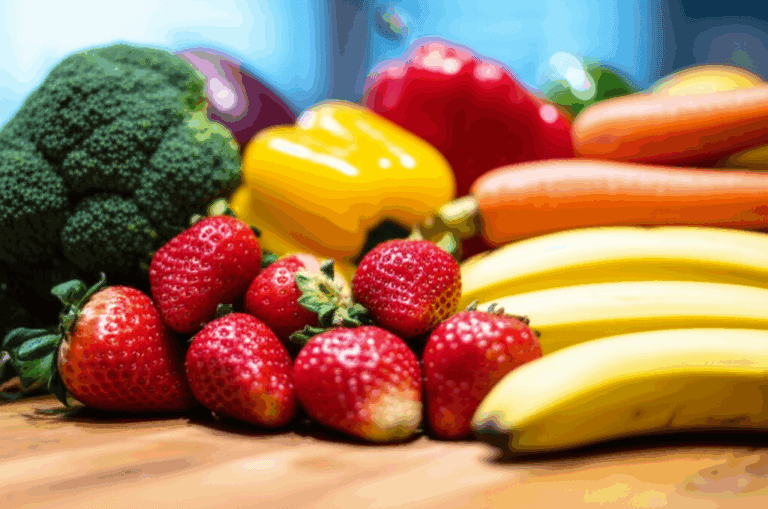Alarming new data reveals that most adults are falling short of their daily recommended intake of fruits and vegetables. We all know these foods are nutritional powerhouses, vital for good health, but incorporating them into our busy lives can feel like a chore. Fear not! This guide is packed with actionable tips and tricks to effortlessly boost your fruit and veggie consumption and finally achieve your 5-a-day goal.
The 5-A-Day Dilemma: Why Are We Failing?
Despite widespread knowledge of the benefits of fruits and vegetables, studies consistently show that a significant portion of the population doesn’t consume the recommended five servings daily. According to the CDC, a staggering 90% of Americans don’t get enough vegetables, and 87% don’t eat enough fruit. Why is there such a disconnect between knowing and doing?
Several factors contribute to this shortfall:
- Busy Lifestyles: Hectic schedules often leave little time for meal planning and preparation, leading to reliance on convenient but often less healthy options.
- Limited Access: Access to fresh, affordable produce can be a challenge in certain areas, contributing to dietary disparities.
- Taste Preferences: Some individuals simply don’t enjoy the taste or texture of certain fruits and vegetables, making it difficult to incorporate them into their diets.
- Lack of Awareness: Many people underestimate what constitutes a serving of fruits and vegetables, leading to inaccurate self-reporting of their intake.
Decoding the 5-A-Day Recommendation
Before diving into the tips, let’s clarify what “5-a-day” actually means. Health organizations recommend consuming at least five portions of a variety of fruits and vegetables each day. An adult portion is 80g.
Here’s a handy guide to typical portion sizes:
- Small Fruits: 2 or more small fruits (e.g., 2 plums, 2 satsumas, 7 strawberries)
- Medium Fruits: 1 medium fruit (e.g., 1 apple, banana, orange)
- Large Fruits: ½ grapefruit, 1 slice of papaya, 1 slice of melon
- Dried Fruit: 30g (about 1 heaped tablespoon of raisins)
- Green Vegetables: 2 broccoli spears, 2 heaped tablespoons of cooked spinach
- Salad Vegetables: 3 celery sticks, 1 medium tomato, 7 cherry tomatoes
- Pulses and Beans: 3 heaped tablespoons of baked beans, kidney beans, etc.
Simple Strategies for Hitting Your 5-A-Day
Ready to transform your eating habits? Here are practical and easy-to-implement strategies to help you effortlessly incorporate more fruits and vegetables into your daily routine:
1. Start Your Day Right
- Fruit with Breakfast: Kickstart your day with a serving or two of fruit. Add berries, sliced bananas, or peaches to your cereal, oatmeal, or yogurt.
- Smoothie Power: Blend a quick and nutritious smoothie with fresh or frozen fruit and a handful of spinach or kale. You won’t even taste the greens!
- Veggie Omelets: Load up your omelets with chopped vegetables like peppers, onions, spinach, and mushrooms.
2. Sneak Them into Your Everyday Eats
- Grate and Shred: Add shredded carrots or zucchini to your favorite pasta sauce, meatball recipe, or baked goods.
- Blend and Puree: Incorporate pureed vegetables like butternut squash or sweet potato into soups, sauces, and even mac and cheese for a hidden boost of nutrients.
- Top It Off: Sprinkle nuts and diced fruit onto your oatmeal, yogurt, or salads for added flavor and texture.
3. Make Smart Swaps
- Veggie Noodles: Replace traditional pasta with zucchini or sweet potato noodles for a nutrient-packed meal.
- Fruit-Based Desserts: Opt for fruit-based desserts like berries and cream or baked apples instead of processed sweets.
- Cauliflower Power: Substitute cauliflower rice for white rice or use cauliflower to make pizza crust for a low-carb, veggie-rich alternative.
4. Snack Smarter
- Keep it Visible: Place a bowl of washed and ready-to-eat fruits on your kitchen counter or in the front of your fridge to make them easily accessible.
- Prepare Grab-and-Go Bags: Portion out single-serving bags of carrot sticks, cucumber slices, or bell pepper strips for quick and healthy snacks on the go.
- Pair with Protein: Combine fruit or vegetable snacks with a source of protein, such as a handful of nuts, a dollop of peanut butter, or a piece of cheese, for sustained energy and satiety.
- Dried Fruit Delight: A small portion of dried fruit can be a convenient and satisfying snack, but remember that it’s high in sugar, so consume it in moderation.
5. Lunchtime Leaps
- Soup It Up: Pack homemade vegetable soup for lunch, or choose a store-bought option with the lowest sodium content.
- Salad Sensation: Build a vibrant salad with at least 3 cups of leafy greens and add a variety of chopped vegetables and fruits for flavor and texture.
- Wrap It Up: Add extra vegetables to your sandwich or wrap. If eating out, ask for extra veggies.
- Leftover Love: Use leftover vegetables from the previous night’s dinner as a side dish for lunch.
6. Dinner Domination
- Stir-Fry Success: Make stir-fries for dinner with a generous amount of colorful vegetables.
- Grill It Up: Grill vegetables with a minimal amount of oil or oil spray. Thread them on kebabs or toss them in a grill basket.
- Pasta Power: Add extra vegetables to pasta sauces, casseroles, and soups. Good options include onions, peas, beans, tomatoes, peppers, and spinach.
- Roast to Perfection: Roast vegetables for an easy and flavorful side dish.
- Soup’s On: Serve a vegetable-based soup, such as hearty mixed vegetable, squash, cauliflower, potato, corn, or broccoli soup.
7. Make it Fun and Flavorful
- Experiment with Herbs and Spices: Enhance the flavor of vegetables with herbs, spices, and seasonings.
- Get Creative with Cooking Methods: Try different cooking methods like roasting, grilling, steaming, and sautéing to discover your favorite ways to prepare vegetables.
- Try New Varieties: Explore different types of fruits and vegetables to discover new flavors and textures. Visit your local farmers market for seasonal options.
- Make it a Family Affair: Involve your family in meal planning and preparation to encourage healthy eating habits for everyone.
8. Optimize Your Shopping
- Plan Ahead: Create a shopping list based on your meal plan to ensure you have the necessary fruits and vegetables on hand.
- Buy in Season: Purchase fruits and vegetables that are in season for the best flavor and value.
- Don’t Fear Frozen: Frozen fruits and vegetables are just as nutritious as fresh and can be a convenient option for extending shelf life.
- Stock Up on Staples: Keep a supply of canned beans, tomatoes, and other versatile vegetables in your pantry for quick and easy meals.
9. Stay Hydrated
- Fruit-Infused Water: Add slices of fruits or berries to your water for a flavorful hydration boost.
- Vegetable Juices: Opt for low-sodium vegetable juices for a quick and easy way to get an extra serving of vegetables.
- Limit Sugary Drinks: Replace sugary drinks with water, unsweetened tea, or sparkling water to reduce your overall sugar intake and make room for more fruits and vegetables.
10. Mindful Eating
- Pay Attention to Portion Sizes: Be mindful of serving sizes to ensure you’re consuming adequate amounts of fruits and vegetables.
- Eat Slowly and Savor the Flavors: Take the time to enjoy the taste and texture of your food, which can help you feel more satisfied and less likely to overeat.
- Listen to Your Body’s Cues: Pay attention to your hunger and fullness cues to avoid unnecessary snacking and promote healthy eating habits.
Overcoming Obstacles
It’s not always easy to change your eating habits, and you may encounter some challenges along the way. Here are some tips for overcoming common obstacles:
- “I don’t like vegetables”: Start with milder-tasting vegetables like spinach, zucchini, and carrots, and try preparing them in different ways to find what you enjoy.
- “I don’t have time to cook”: Opt for quick and easy recipes that require minimal preparation, or purchase pre-cut and washed fruits and vegetables to save time.
- “Fruits and vegetables are too expensive”: Buy in season, shop at farmers markets, and compare prices at different stores to find the best deals.
- “I’m always on the go”: Pack healthy snacks like fruit, vegetables, and nuts to avoid unhealthy impulse purchases when you’re out and about.
The Long-Term Benefits
Consistently incorporating at least five servings of fruits and vegetables into your daily diet offers a wealth of long-term health benefits:
- Reduced Risk of Chronic Diseases: Studies have shown that a high intake of fruits and vegetables is associated with a lower risk of heart disease, stroke, type 2 diabetes, and certain types of cancer.
- Improved Weight Management: Fruits and vegetables are low in calories and high in fiber, which can help you feel full and satisfied, making it easier to maintain a healthy weight.
- Enhanced Digestive Health: The fiber in fruits and vegetables promotes healthy digestion and can help prevent constipation and other digestive issues.
- Boosted Immunity: Fruits and vegetables are rich in vitamins, minerals, and antioxidants, which support a healthy immune system and protect against illness.
- Improved Skin Health: The antioxidants in fruits and vegetables can help protect your skin from damage caused by free radicals, promoting a healthy and radiant complexion.
Making 5-A-Day a Sustainable Habit
Achieving your 5-a-day goal is not just about following a set of rules, it’s about making sustainable lifestyle changes that you can maintain over the long term. Start small, be patient with yourself, and focus on making gradual changes that fit into your lifestyle.
- Set Realistic Goals: Don’t try to overhaul your entire diet overnight. Start by adding one extra serving of fruits or vegetables to your daily routine and gradually increase your intake over time.
- Track Your Progress: Keep a food diary or use a mobile app to track your fruit and vegetable consumption and monitor your progress.
- Reward Yourself: Celebrate your successes along the way to stay motivated and reinforce your healthy habits.
- Don’t Give Up: If you slip up and miss a day or two, don’t get discouraged. Just get back on track as soon as possible and keep moving forward.
By implementing these simple strategies and making a conscious effort to prioritize fruits and vegetables in your diet, you can effortlessly achieve your 5-a-day goal and reap the numerous health benefits that come with it. So, start today and make a commitment to nourish your body with the goodness of nature!







